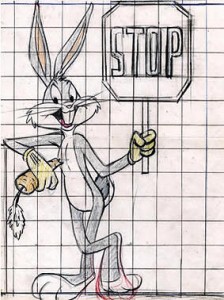What’s Up, Chuck Jones? New Museum Exhibit Pays Tribute to Bugs Bunny’s Creator
Posted on June 1, 2014 at 8:00 am
“Eschew the ordinary, disdain the commonplace. If you have a single-minded need for something, let it be the unusual, the esoteric, the bizarre, the unexpected.”
Chuck Jones
Animation director and artist Charles Martin “Chuck” Jones (1912–2002) was often asked whether he made his legendary cartoons for adults or children. He always answered that he made them for himself and his colleagues at the famous Termite Terrace. Jones perfected the wisecracking Bugs Bunny and the exasperated Daffy Duck and a host of other characters, including Wile E. Coyote, the Road Runner, and Pepé Le Pew. What’s Up, Doc? The Animation Art of Chuck Jones is a new Smithsonian traveling exhibition that explores Jones’s creative genius, influences, and legacy, opening at Museum of the Moving Image in New York City on July 19, 2014 and on view through January 19, 2015.
The exhibition is a partnership between the Smithsonian Institution Traveling Exhibition Service, the Academy of Motion Picture Arts and Sciences, the Chuck Jones Center for Creativity, and Museum of the Moving Image. After debuting at the Museum, the exhibition will continue on a thirteen-city tour through 2019.
“Chuck Jones is one of the enduring geniuses of American comedy, as accomplished in the art of animation as his hero Mark Twain was in literature,” said David Schwartz, Chief Curator of Museum of the Moving Image, who curated the exhibition with Barbara Miller, the Museum’s Curator of the Collection and Exhibitions. “His work is marked by its ability to convey the distinctive personality of his characters, his endless comic invention, and his mastery of timing and visual and verbal humor.”
In an interview produced for the exhibition, John Lasseter, director of Toy Story and Toy Story 2, and Chief Creative Officer at Pixar, said “Chuck Jones’s cartoons are timeless. They are as funny today as when they were made.”
What’s Up, Doc? The Animation Art of Chuck Jones features 23 of Chuck Jones’s animated films, a short documentary and an interactive experience—both of which give insight into the animation process—and more than 125 original sketches and drawings, storyboards, production backgrounds, animation cels, and photographs that reveal how Jones and his collaborators worked together to create some of the greatest cartoons ever made. In addition to the cartoons Jones made for the Warner Bros.’s Merrie Melodies and Looney Tunes series, the exhibition explores his collaborations with author Theodore Geisel on the enduringly popular television specials Dr. Seuss’ How the Grinch Stole Christmas (1966) and Horton Hears a Who! (1970); films that featured the hapless animated character Private Snafu, made for the U.S. Army during World War II; the Oscar®-winning public health film So Much for So Little (1949); and the television special Rikki-Tikki-Tavi (1975), based on a story by Rudyard Kipling.
Among the artifacts in the exhibition are a production sheet from Jones’s directorial debut The Night Watchman (1938); layout artist Maurice Noble’s background designs for such popular favorites as Duck Amuck (1953) and Duck Dodgers in the 24½th Century (1953); a range of artwork created for Jones’s masterpiece What’s Opera, Doc? (1957); Jones’s character layout drawings that showed his animators how a character, such as Bugs Bunny or Wile E. Coyote, should move in a particular scene; and animation cels from Dr. Seuss’ How the Grinch Stole Christmas.
The films, shown as large wall projections and on monitors throughout the exhibition, include such classic Warner Bros. cartoons as What’s Opera, Doc? and One Froggy Evening (1955), and the Academy Award-winning short The Dot and the Line: A Romance in Lower Mathematics (1965), which expanded the boundaries of the medium with its experimental techniques. Some of the films and clips include introductions by John Lasseter.
The exhibition also includes behind-the-scenes audio of Jones directing Mel Blanc (voice of Bugs Bunny) and Arthur Q. Bryan (Elmer Fudd), and excerpts from interviews with Jones. An interactive experience will allow visitors to take on the role of animation director by manipulating character movement and timing.
